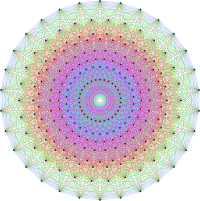Dynkin diagram

A Dynkin diagram is like a picture made up of little circles, lines and arrows that helps us understand how different mathematical objects are related to each other.
Think of it like drawing a map to help you find your way around a big city. The circles on the Dynkin diagram represent different “places” or objects that we want to understand, and the lines and arrows are like streets or paths that connect them.
Each circle represents one of the mathematical objects we are studying, and the lines or arrows between the circles tell us how they are related to each other. For example, if there is a line between two circles on the diagram, it means that these objects are closely related in some way.
The Dynkin diagram can also tell us something about the structure of the objects we are studying. By looking at how the circles are arranged and how they are connected, we can learn more about the different types of symmetries or transformations that these objects undergo.
Overall, the Dynkin diagram is a helpful tool for understanding the relationships between different mathematical objects and for uncovering the underlying patterns and structure that they share.
Think of it like drawing a map to help you find your way around a big city. The circles on the Dynkin diagram represent different “places” or objects that we want to understand, and the lines and arrows are like streets or paths that connect them.
Each circle represents one of the mathematical objects we are studying, and the lines or arrows between the circles tell us how they are related to each other. For example, if there is a line between two circles on the diagram, it means that these objects are closely related in some way.
The Dynkin diagram can also tell us something about the structure of the objects we are studying. By looking at how the circles are arranged and how they are connected, we can learn more about the different types of symmetries or transformations that these objects undergo.
Overall, the Dynkin diagram is a helpful tool for understanding the relationships between different mathematical objects and for uncovering the underlying patterns and structure that they share.
Related topics others have asked about:
